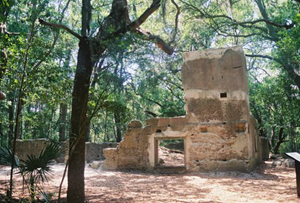The Stoneys, the Baynards, and Their Mansion
by Lyman Wooster
A mansion on Braddock Point Plantation (in the area now known as Sea Pines) was owned and occupied in the antebellum era by two families, the Stoneys and the Baynards. The tabby home was built by the former and subsequently purchased and later deserted by the latter, so that it is now called the Stoney-Baynard Ruins. The ruins are located off of Plantation Drive.
John (Captain Jack) Stoney, born in Tipperary, Ireland, and his wife, Elizabeth, arrived in South Carolina in 1774 in his own merchant vessel, the “Saucy Jack.” He engaged in America’s War for Independence as a privateer, acquired a sizable fortune in the process, and purchased the 1,000-acre Braddock Point Plantation in 1776. Stoney was one of four Hilton Head patriots honored by the local chapter of the Sons of the American Revolution for their role in America’s struggle for independence, all of whom are buried in the Zion Cemetery. The cemetery is at the junction of US-278 and Matthews Drive.
In 1793, Stoney, with the help of slave laborers, began the construction of a mansion on the Braddock Point Plantation. It was a structure, 40 by 46 feet, with a tabby foundation. When completed it probably appeared much larger than its 1840 square feet for it apparently had a front porch and may have had another porch that was in effect a wrap-around affair.
Tabby is a cement used chiefly along the coast of South Carolina and Georgia in the 17th and 18th Centuries; it is made of oyster shells, lime, sand, and water.
Stoney is also remembered for his role in, with Isaac Fripp, founding in 1788 the Zion Chapel of Ease, an Episcopal church approved by St Luke’s Parish. The chapel was made of wood on a brick foundation and had completely disappeared by three years after the Civil War ended. Its communicants had departed in 1861 with the arrival on the island in November of Federal troops. What remains today of Zion is the cemetery.
John Stoney was killed in a hunting accident in 1821 and was initially buried where he fell, near Fish Haul Creek at the other end of the shoe-shaped island from his Braddock Point home. According to the tablet identifying his tomb, John Stoney’s remains were re-buried in the Zion Cemetery in 1959.
The Stoneys, who became in the early part of the 19th century the largest land owners on Hilton Head, had two sons who lived to maturity and were in effect partners after their father died. John moved to Charleston where he was a merchant and apparently the manager of the Hilton Head plantations’ finances, while James remained on the island overseeing the property’s agriculture production. That property was considerable: at one time Stoneys owned Fairfield, Possum Point, Shipyard, and Honey Horn Plantations as well as Braddock Point.
James died in 1827, and John, known as “Saucy Jack,” died in 1838, by which time the Stoney property had been mortgaged to the Bank of Charleston. A melodramatic tale that has received frequent retelling is that “Saucy Jack” lost the Braddock Point property to William E. Baynard in a high-stakes poker game. It is more likely that Baynard purchased the 1,000 acre plantation from the Charleston bank for $10,000 in 1840.
William Eddings Baynard came to Hilton Head from Edisto; at the time he acquired the Braddock Point property he already owned Spanish Wells and Muddy Creek Plantations on Hilton Head, and there at those plantations and at Braddock Point he raised the well-regarded and highly profitable Sea Island (long-staple) cotton. A research project by the Chicora Foundation provides some data on Baynard’s Braddock Point Plantation. Its report notes that an 1850 South Carolina Agriculture Census indicates that the plantation produced 36 bales of cotton (a bale or bag of long staple cotton weighed between 300 and 400 pounds), 1,000 bushels of corn, 500 bushels of peas, 1,000 bushels of sweet potatoes, and 350 pounds of butter. It was estimated that crops and animals were valued at $12,000, a sizeable amount in 1850 dollars. The Chicora report noted that “in comparison with other known Hilton Head plantations the Baynard Plantation appears to meet the norm -- clearly more wealthy than some, less than others.”
That William E. Baynard moved from Edisto to become a permanent Hilton Head resident is supported by the fact that he had had constructed a mausoleum in Zion Cemetery in 1846. It is now the oldest remaining intact structure on Hilton Head.
Baynard died in 1849, three years after the mausoleum was built, when he was 49 years of age. He was joined in the mausoleum by his widow five years later.
The tomb is currently empty which is credible confirmation of reports that the mausoleum has been the object of scavengers, although tales as to who and when illegal entries were made cannot now be confirmed -- nor can the ghost stories associated with the mausoleum and the Baynards.
The Baynard holdings were inherited by William’s son, Ephram, who retained and managed them until 1861. When the Union Army occupied the island in November of that year Baynard, like the communicants of Zion’s Chapel and most of the landowners in Hilton Head, departed.
The Baynards later paid $533 in back taxes they owed so they could reclaim the Hilton Head property but the family never attempted to rebuild the mansion.
Federal forces are said to have used the Braddock Point mansion as quarters as late as 1864. Subsequently it was burned; some say Confederates were the arsonists. What remains are the mansion’s tabby foundation, a corner wall, and the foundations of several outbuildings, plus informative postings for the benefit of visitors to the ruins.



